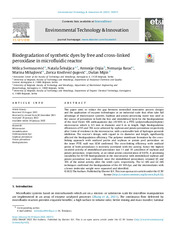Приказ основних података о документу
Biodegradation of synthetic dyes by free and cross-linked peroxidase in microfluidic reactor
| dc.creator | Svetozarević, Milica | |
| dc.creator | Šekuljica, Nataša | |
| dc.creator | Onjia, Antonije | |
| dc.creator | Barać, Nemanja | |
| dc.creator | Mihajlović, Marina | |
| dc.creator | Knežević-Jugović, Zorica | |
| dc.creator | Mijin, Dušan | |
| dc.date.accessioned | 2022-03-04T09:36:50Z | |
| dc.date.available | 2022-03-04T09:36:50Z | |
| dc.date.issued | 2022 | |
| dc.identifier.issn | 2352-1864 | |
| dc.identifier.uri | http://TechnoRep.tmf.bg.ac.rs/handle/123456789/4729 | |
| dc.description.abstract | This paper aims to reduce the gap between intensified innovative process designs and the application of enzyme technologies at an industrial scale that often take full advantage of microreactor systems. Soybean and potato processing waste was used as the source of peroxidase in both the free and immobilized form for the biodegradation of the Acid Violet 109 anthraquinone dye (AV109) in a PTFE (polytetrafluoroethylene) microreactor which is 0.5 mm in diameter and 6 m in length. High biodegradation efficiencies of 95 and 76% were achieved by soybean and potato peroxidase respectively after 3 min of residence in the microreactor, with a noticeable lack of hydrogen peroxide inhibition. The reactor’s design, with regard to its diameter and length, significantly affected the biodegradation efficiency. The polymer membrane formation by the cross-linking approach with oxidized pectin and soybean or potato peel peroxidase on the inner PTFE wall was SEM confirmed. The cross-linking efficiency with oxidized pectin of both peroxidases is inversely correlated with the activity, hence the highest recorded activity of immobilized peroxidase was 11 and 19μmol/min of soybean and potato peroxidase, respectively, at an initial pectin concentration of 0.05%. A promising reusability for AV109 biodegradation in the microreactor with immobilized soybean and potato peroxidase was confirmed, since the immobilized peroxidases retained 65 and 35% of the initial activity after the tenth cycle, respectively. The LC–MS and GC–MS techniques confirmed the biodegradation of the AV 109 dye, and the intermediates with a lower molecular weight were separated and identified. | |
| dc.language | en | |
| dc.publisher | Elsevier B.V. | |
| dc.relation | info:eu-repo/grantAgreement/MESTD/inst-2020/200287/RS// | |
| dc.relation | info:eu-repo/grantAgreement/MESTD/inst-2020/200135/RS// | |
| dc.relation.isreferencedby | http://technorep.tmf.bg.ac.rs/handle/123456789/4730 | |
| dc.rights | openAccess | |
| dc.rights.uri | https://creativecommons.org/licenses/by/4.0/ | |
| dc.source | Environmental Technology & Innovation | |
| dc.subject | Anthraquinone dye | |
| dc.subject | Biodegradation | |
| dc.subject | Immobilization | |
| dc.subject | Microreactor | |
| dc.subject | Potato peroxidase | |
| dc.subject | Soybean peroxidase | |
| dc.title | Biodegradation of synthetic dyes by free and cross-linked peroxidase in microfluidic reactor | |
| dc.type | article | en |
| dc.rights.license | BY | |
| dc.citation.rank | M21~ | |
| dc.citation.spage | 102373 | |
| dc.citation.volume | 26 | |
| dc.description.other | Supplementary material: [http://technorep.tmf.bg.ac.rs/handle/123456789/4730] | |
| dc.identifier.doi | 10.1016/j.eti.2022.102373 | |
| dc.identifier.fulltext | http://TechnoRep.tmf.bg.ac.rs/bitstream/id/7315/1-s2.0-S2352186422000542-main.pdf | |
| dc.identifier.scopus | 2-s2.0-85124697703 | |
| dc.identifier.wos | 00083287670000 | |
| dc.type.version | publishedVersion |

